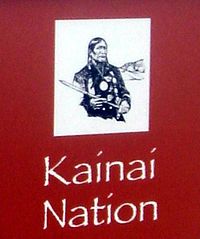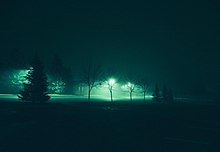
Back كايناي Arabic كايناى ARZ Каінава Byelorussian Kainai German Gens-du-Sang French Kainah Croatian Kainah Italian Kainajai Lithuanian Kainainasjonen NN Кайна (племя) Russian
 Shield of the Kainai Nation | |
| People | Blackfoot |
|---|---|
| Treaty | Treaty 7 |
| Headquarters | Stand Off |
| Province | Alberta |
| Land[1] | |
| Main reserve | Blood 148 |
| Other reserve(s) | |
| Land area | 1362.639 km2 |
| Population (2021)[1] | |
| On reserve | 4,572[2] |
| Total population | 12,963 |
| Government[1] | |
| Chief | Roy Fox |
| Council |
|
| Website | |
| bloodtribe | |


The Kainai Nation (Blackfoot: ᖿᖱᖻᖳ, romanized: Káínaa or ᖿᖱᖻᖷ, romanized: Káínawa, Blood Tribe) is a First Nations band government in southern Alberta, Canada, with a population of 12,965 members in 2024,[3] up from 11,791 in December 2013.[4]
Akáínaa translates directly to 'many chief' (from aká, 'many' and nínaa, 'chief') while Káína translates directly to 'many chief people'. The enemy Plains Cree call the Kainai mihkowiyiniw,[5] 'stained with blood', thus 'the bloodthirsty, cruel', therefore, the common English name for the tribe is the Blood tribe.
The Kainai speak a language of the Blackfoot linguistic group; their dialect is closely related to those of the Siksika and Piikani. They are one of three nations comprising the Blackfoot Confederacy.
At the time treaties such as Treaty 7 were signed, the Kainai were situated on the Oldman, Belly, and St. Mary rivers west of Lethbridge, Alberta. The Kainai reserve Blood 148 is currently the largest in Canada with 4,570 inhabitants[6] on 1,410 km2 (545 sq mi) and is located 200 kilometres (120 mi) south of Calgary.
- ^ "First Nation Detail: Blood". Indigenous and Northern Affairs Canada. Government of Canada. Retrieved August 20, 2019.
- ^ "Statistics Canada, 2021 Census of Population". Statistics Canada. Statistics Canada. Retrieved 16 April 2024.
- ^ Branch, Government of Canada; Indigenous and Northern Affairs Canada; Communications (2008-11-14). "First Nation Profiles". fnp-ppn.aadnc-aandc.gc.ca. Retrieved 2024-08-02.
{{cite web}}: CS1 maint: multiple names: authors list (link) - ^ Blood Tribe Registered Population - Aboriginal Affairs and Northern Development Canada - "Registered Population: Blood". Crown–Indigenous Relations and Northern Affairs Canada. Government of Canada. Retrieved 2014-01-23.
- ^ "Search results". www.creedictionary.com. Retrieved 2023-02-02.
- ^ [1] - 2016 Census Aboriginal Population Profile